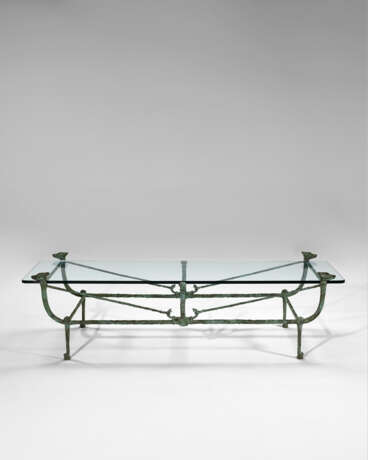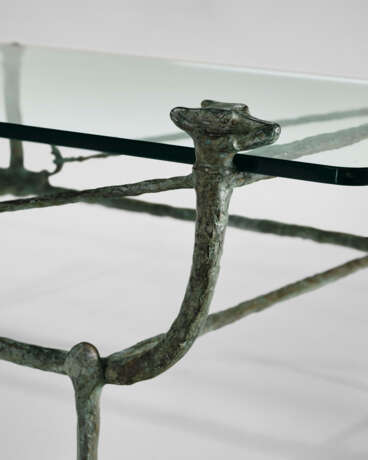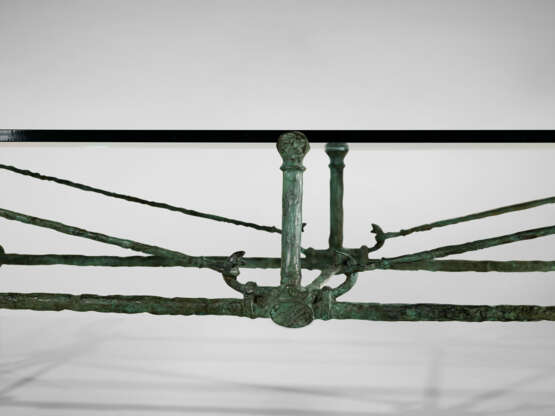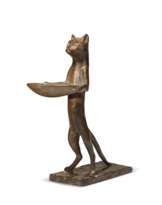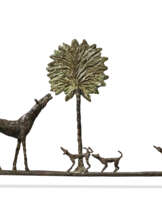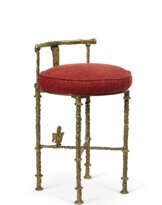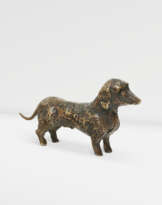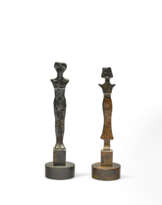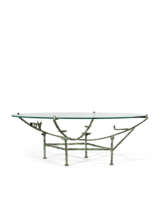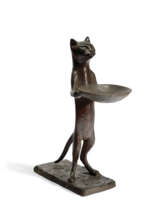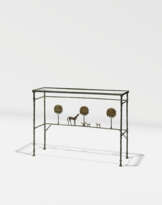ID 778996
Lot 168 | DIEGO GIACOMETTI (1902-1985)
Valeur estimée
$ 1 400 000 – 1 800 000
'Berceau' Low Table, Modèle aux Renards, designed circa 1975
patinated bronze, glass
22 x 76 3⁄4 x 34 1⁄2 in. (55.9 x 194.9 x 87.6 cm)
impressed DIEGO and with artist's monogram
Provenance
Lee Kolker, acquired directly from the artist, 1978-1979
DeLorenzo Gallery, New York
Acquired from the above by the present owner
Literature
M. Butor, Diego Giacometti, Paris, 1985, pp. 144-147 (for a related example)
D. Marchesseau, Diego Giacometti, New York, 1986, pp. 88-89 (for a related example)
Special notice
On occasion, Christie's has a direct financial interest in the outcome of the sale of certain lots consigned for sale. This will usually be where it has guaranteed to the Seller that whatever the outcome of the auction, the Seller will receive a minimum sale price for the work. This is known as a minimum price guarantee. This is such a lot.
On occasion, Christie's has a direct financial interest in the outcome of the sale of certain lots consigned for sale. This will usually be where it has guaranteed to the Seller that whatever the outcome of the auction, the Seller will receive a minimum sale price for the work. This is known as a minimum price guarantee. Where Christie's has provided a Minimum Price Guarantee it is at risk of making a loss, which can be significant, if the lot fails to sell. Christie's therefore sometimes chooses to share that risk with a third party. In such cases the third party agrees prior to the auction to place an irrevocable written bid on the lot. The third party is therefore committed to bidding on the lot and, even if there are no other bids, buying the lot at the level of the written bid unless there are any higher bids. In doing so, the third party takes on all or part of the risk of the lot not being sold. If the lot is not sold, the third party may incur a loss. The third party will be remunerated in exchange for accepting this risk based on a fixed fee if the third party is the successful bidder or on the final hammer price in the event that the third party is not the successful bidder. The third party may also bid for the lot above the written bid. Where it does so, and is the successful bidder, the fixed fee for taking on the guarantee risk may be netted against the final purchase price.
Third party guarantors are required by us to disclose to anyone they are advising their financial interest in any lots they are guaranteeing. However, for the avoidance of any doubt, if you are advised by or bidding through an agent on a lot identified as being subject to a third party guarantee you should always ask your agent to confirm whether or not he or she has a financial interest in relation to the lot.
Post lot text
Diego Giacometti’s superbly executed ‘Berceau’ Low Table, Modèl aux Renards captures the sense of elegance and grace inherent in the artist’s best work. Commissioned by the renowned collector Lee Kolker, the table’s four elegant foxes heads that each guard a corner combined with the tactility of Giacometti’s iconic surfaces, are ample evidence of the artist’s love of natural forms. Together with Alberto, the Giacometti brothers were responsible for some of the most evocative and enigmatic sculptural forms of the twentieth-century. While his older brother concentrated on his iconic Standing Woman and Walking Man (works in which Diego also played an important role), Diego’s creative contribution came to the fore in his elegant furniture designs.
Maintaining the elegance of the aesthetic for which the pair’s sculptural work is celebrated, the gently curving silhouette of Diego’s table also displays his discrete sense of humility, “Diego’s works is like a hymn to modesty,” writes design journalist François Baudot (F. Baudot, Diego Giacometti, 2001, p. 11). The fox was a particularly personal motif for Diego. When a friend who had survived the horrors of the concentration camps in Europe returned to Paris, she brought with her a tamed fox who she proceeded to keep chain up in her apartment. Diego was horrified and insisted that he take the animal to his studio where it could roam in relative freedom of the large rooms and open courtyard. The fox—who Diego named Miss Rose on account of the color of her light reddish brown fur—became a kindred spirits of sorts and the two often spent time in each other’s company. When Alberto returned to Paris after the end of the war, he was not pleased with the new ‘resident,’ particularly the accompanying smell. One night, after Diego had left for the day, Alberto ‘accidently’ forgot to close the studio door and Miss Rose disappeared off into the Parisian night, never to be seen again.
Diego began making decorative objects as early as the 1930s, but World War Two and his brother’s burgeoning career forced him to focus his attention elsewhere. Diego worked directly with his brother in the studio, making the aerial framework for his brother’s silhouettes, molding the plaster, and applying the patinas to the finished bronzes. Like his brother, Diego was a perfectionist and spent hours achieving the tactile surfaces for which they became known.
Diego designed his first tables for the French art dealer Aimé Maeght, and the film producer Raoul Lévy. He would go to design major commissions for the house of Aimé and Marguerite Maeght in Saint-Paul-de-Vence, and properties owned by Pierre Matisse in New York and Cap Ferrat. After Alberto’s death in 1966, Diego was able to concentrate on his own designs, building on the skills he had acquired to develop a menagerie of foxes, tawny owls, frogs, pigeons, and cats. He said they reminded him of the wildlife the saw growing up in Switzerland, and with these dreamlike characters Diego began exploring an aspect of life that distanced him radically from the work he was so devoted to in peacetime, producing sublime works that capture the artist’s joyous embodiment of the sculptural process.
| Artiste: | Diego Giacometti (1902 - 1985) |
|---|---|
| Matériel: | Verre, Bronze patiné |
| Catégorie maison de vente aux enchères: | Meubles et Lampes, Tables |
| Artiste: | Diego Giacometti (1902 - 1985) |
|---|---|
| Matériel: | Verre, Bronze patiné |
| Catégorie maison de vente aux enchères: | Meubles et Lampes, Tables |
| Adresse de l'enchère |
CHRISTIE'S 8 King Street, St. James's SW1Y 6QT London Royaume-Uni | |
|---|---|---|
| Aperçu |
| |
| Téléphone | +44 (0)20 7839 9060 | |
| Commission | see on Website | |
| Conditions d'utilisation | Conditions d'utilisation |
